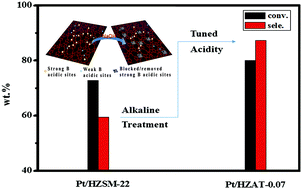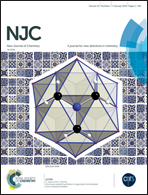Enhanced n-dodecane hydroisomerization performance by tailoring acid sites on bifunctional Pt/ZSM-22 via alkaline treatment†
Abstract
Acidity controlled Pt/ZSM-22 catalysts for n-dodecane hydroisomerization were explored through a simple and efficient post-treatment with different NaOH concentrations, and then the resulting samples were characterized using acid measurement, XRD, SEM, TEM, XRF and XPS. It appeared that the high crystallinity, uniform morphology and textural structure almost remained even after the alkaline-treatment of the parent zeolite with a low Si/Al ratio (∼20). However, the distribution of acid sites, and in particular the Brønsted acidity, changed which then affected the catalytic performance. This originates from the Brønsted acid sites of the parent catalyst being partially blocked. With the acid sites optimized using the alkali treatment, the selectivity for isomers increased from 59.5% (parent sample) to 87.3% (treated sample) with the yield increasing from 43.3% to 69.8%. Thus, such an ordinary alkaline treatment proved to be promising in the n-paraffin hydroisomerization for the cleaner production of lubricating oil based stocks.



 Please wait while we load your content...
Please wait while we load your content...